29th April 2014
By Eric Biggane
The simple answer to this is that you can’t tell the difference without identifying the individual mushroom you have found. Some poisonous mushrooms can kill, so you must be able to accurately name the fungus and be 100% sure of what it is before consumption.
There are some apparent rules for picking safe mushrooms but these are just fanciful if not downright dangerous;
- ‘It’s ok if you can peel the cap.’ It is easy to peel a Death Cap.
- ‘Mushrooms growing on wood are safe.’ No not all of them are and some are deadly, like the Funeral Bell.
- ‘If you see other animals eating them they are ok.’ This rule is not true, many animals can eat poisonous fungi with no ill effects.
Some good rules apply for avoiding poisonous mushrooms if you are a novice;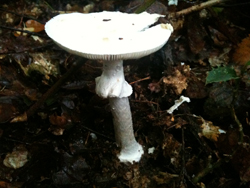
- Avoid mushrooms with white gills, a skirt or ring on the stem and a bulbous or sack like base called a volva. You may be missing out on some good edible fungi but it means you will be avoiding the deadly members of the Amanita family.
- Avoid mushrooms with red on the cap or stem. Again you will be missing out on some good mushrooms but more importantly you won’t be picking poisonous ones.
 Finally don’t consume any mushrooms unless you are 100% sure of what they are. I know I have already mentioned this but it is by far the most important rule.
Finally don’t consume any mushrooms unless you are 100% sure of what they are. I know I have already mentioned this but it is by far the most important rule.
These rules don’t mean all other mushrooms are safe but help rule out some of the nastier types.
Some UK mushrooms are easy to identify so quite safe to eat, the Giant Puffball, Beefsteak Fungus, Porcelain Fungus, Cauliflower Fungus, Dryads Saddle, the Hedgehog Fungus, if you are very lucky the Truffle, Wood Ears (as long as they are growing on elder) and Chicken of the Woods (as long as it is not growing on a Yew tree). So for the novice forager these are the ones to go for, there are no dangerous lookalikes, so just learn what these mushrooms look like and you should be able to forage for them safely.
Mushrooms for Beginners
A good way to help identify mushrooms is by learning which family the fungus belongs to.
Agarics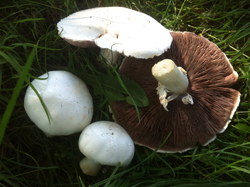 The edible members of the Agaric family all have pink to brown/black gills, a white cap and usually a stout stem with a skirt. There are however toxic members of this family that look very similar. Once you have established that you have an Agaric bruise the cap, if it stains bright chrome yellow it is probably poisonous, if it stains pale yellow, pink or red it is probably edible but there is a further test to establish toxicity. You must smell the mushroom, edible Agarics smell pleasantly of mushroom, some with hints of aniseed or almond, the toxic mushrooms smell of Indian ink or iodine or just chemically and unpleasant.
The edible members of the Agaric family all have pink to brown/black gills, a white cap and usually a stout stem with a skirt. There are however toxic members of this family that look very similar. Once you have established that you have an Agaric bruise the cap, if it stains bright chrome yellow it is probably poisonous, if it stains pale yellow, pink or red it is probably edible but there is a further test to establish toxicity. You must smell the mushroom, edible Agarics smell pleasantly of mushroom, some with hints of aniseed or almond, the toxic mushrooms smell of Indian ink or iodine or just chemically and unpleasant.
Identifying Agarics
Boletes 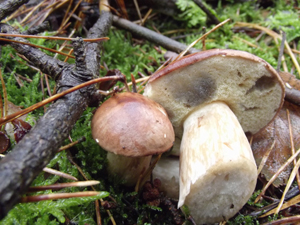 For example the Boletus, Suillus and Leccinum families are easy to identify as they don’t have gills but sponge like pores and generally stout stems. There are two checks to make once you have identified a mushroom as a Bolete to determine its edibility. First, is there any red anywhere on the mushroom including the cap, stem or pores. If there is treat the mushroom as poisonous. Secondly cut the mushroom in half vertically, if the flesh immediately or rapidly stains blue, again treat it as poisonous. If the Bolete in question passes the above tests it isn’t a toxic mushroom. Sticking to the above rules means you will be missing out on some good edible mushrooms but more importantly avoiding any poisonous Boletes.
For example the Boletus, Suillus and Leccinum families are easy to identify as they don’t have gills but sponge like pores and generally stout stems. There are two checks to make once you have identified a mushroom as a Bolete to determine its edibility. First, is there any red anywhere on the mushroom including the cap, stem or pores. If there is treat the mushroom as poisonous. Secondly cut the mushroom in half vertically, if the flesh immediately or rapidly stains blue, again treat it as poisonous. If the Bolete in question passes the above tests it isn’t a toxic mushroom. Sticking to the above rules means you will be missing out on some good edible mushrooms but more importantly avoiding any poisonous Boletes.
Identifying Boletes
Milkcaps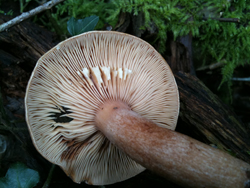 Milkcaps are from the Lactarius family and they mostly exude a milky substance from the gills when touched or damaged. This milk can be very acrid and/or hot so should not be tasted unless you know your Milkcaps or can eat hot chillies raw. Most of the Milkcaps are toxic so until you learn to recognise individual members of this family, stay away from any fungi that ‘lactates’ from the gills. Unfortunately older Milkcaps tend not to lactate so younger mushrooms usually need to be found to aid identification.
Milkcaps are from the Lactarius family and they mostly exude a milky substance from the gills when touched or damaged. This milk can be very acrid and/or hot so should not be tasted unless you know your Milkcaps or can eat hot chillies raw. Most of the Milkcaps are toxic so until you learn to recognise individual members of this family, stay away from any fungi that ‘lactates’ from the gills. Unfortunately older Milkcaps tend not to lactate so younger mushrooms usually need to be found to aid identification.
Russulas The Brittlegills or Russulas have very brittle gills and stems. 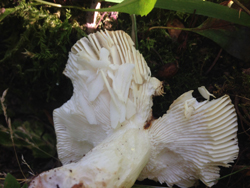 There are many different members of this family, some poisonous some delicious and some that just don’t taste very nice. It is difficult to identify individual Russulas without studying them in depth. A good test for edibility however is the taste test, if a tiny amount is placed on the tongue and chewed a burn like chilli means the mushroom is poisonous, a pleasant mushroomy taste means it is edible and an unpleasant taste means you wouldn’t want to eat the mushroom anyway. This test should only be attempted when you are certain you have a mushroom from the Russula family.
There are many different members of this family, some poisonous some delicious and some that just don’t taste very nice. It is difficult to identify individual Russulas without studying them in depth. A good test for edibility however is the taste test, if a tiny amount is placed on the tongue and chewed a burn like chilli means the mushroom is poisonous, a pleasant mushroomy taste means it is edible and an unpleasant taste means you wouldn’t want to eat the mushroom anyway. This test should only be attempted when you are certain you have a mushroom from the Russula family.
Identifying Russulas
Amanitas The Amanita family all have white gills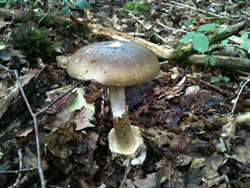 and spores and more importantly most grow from a sack like or bulbous structure called a volva which can be hidden by leaf litter or under the soil surface so it is vital to check the base of any mushroom you are trying to identify. There are a few edible Amanitas but the most poisonous mushrooms in the UK are in this family, the Destroying Angel and the Death Cap, so this family should definitely be avoided by the novice forager.
and spores and more importantly most grow from a sack like or bulbous structure called a volva which can be hidden by leaf litter or under the soil surface so it is vital to check the base of any mushroom you are trying to identify. There are a few edible Amanitas but the most poisonous mushrooms in the UK are in this family, the Destroying Angel and the Death Cap, so this family should definitely be avoided by the novice forager.
Identifying Amanitas
There are many different ways to identify a mushroom and all should be employed when out foraging.
- Where is the mushroom growing, in grassland or woods and what kind of tree they are growing on or under?
- Are the mushrooms growing singley or in a ring, troop or tuft?
- Do the mushrooms have a distinct smell?
- Does the mushroom change colour when cut or bruised?
- What is the size, shape, texture and colour of the cap?
- What is the size, shape and texture of the stem? Does it have a ring/skirt and are there any markings on it? Is the base bulbous or sack like or narrow and rooting?
- Does the mushroom have gills, pores or spikes under the cap? If it has gills how close are they? Do they fork? Are they attached to the stem? Are they brittle or soft and pliable?
- What texture is the flesh?
- What time of year is it?
Always check with a few different guides/pictures as mushrooms can look very different depending on where they are growing, their age and what the weather has thrown at them.
Knowing the colour of the spore print can be very helpful as it helps narrow down your search by telling you what the mushroom isn’t. A spore print can be obtained simply by removing the stem and placing the mushroom gills down on a piece of clear glass or paper for a few hours, preferably overnight.
The colour of the spore print can be very useful to start following ‘keys’ in a mushroom guide.
It may seem like a long list of things to look out for but it soon becomes second nature to check these and be able to safely identify mushrooms in the field.
Finally, don’t be too upset if you can’t always identify a mushroom, I’ve been picking wild mushrooms all my life and still find the odd mushroom I can’t be 100% sure of.
Posted in Tips and Things We Like






































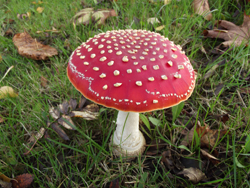 Finally don’t consume any mushrooms unless you are 100% sure of what they are. I know I have already mentioned this but it is by far the most important rule.
Finally don’t consume any mushrooms unless you are 100% sure of what they are. I know I have already mentioned this but it is by far the most important rule.




